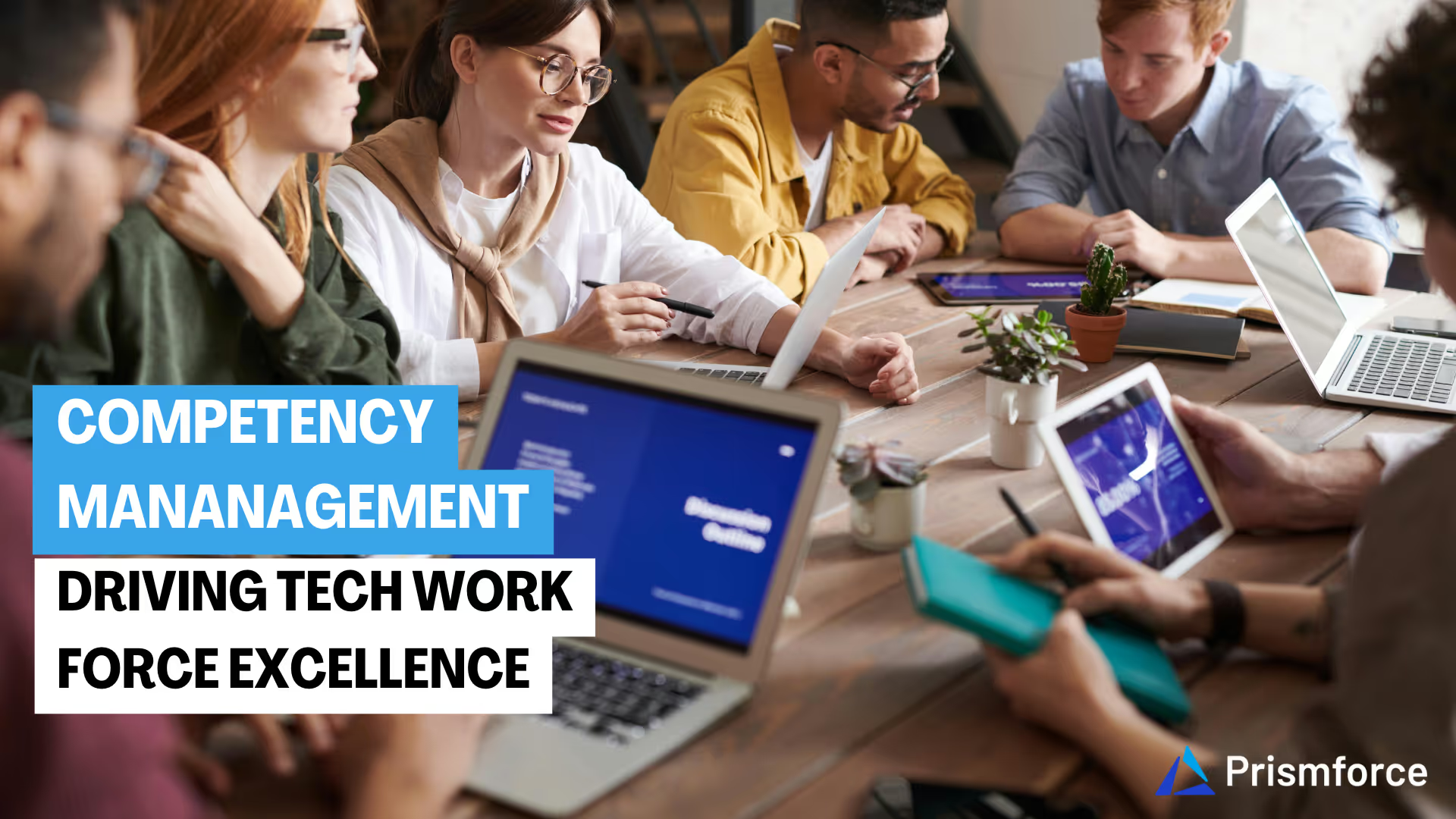
More and more tech companies are focussing on specific skills that are measurable, making sure their business goals and workforce capabilities are in alignment. According to a recent survey by the talent assessment platform TestGorilla, a whopping 88% of tech employers are using skill-based hiring in 2024.
This challenge in the tech industry, however, is the rapid pace of innovation and the ever-evolving nature of technology demands a workforce that can adapt and upskill continuously. In today's competitive tech world, competency management is key to building and keeping a top-notch team.
What is Competency Management?
Competency management is a systematic approach to identifying, assessing, and developing the knowledge, skills, and behaviors (competencies) that employees need to perform their roles effectively and contribute to organizational success.
It involves defining the competencies required for each job role, evaluating employees' current competency levels, and implementing targeted development plans to close any Competency management that aligns employee skills with company goals. It creates a common framework for talent management. This framework helps organizations:
- Identify needed skills
- Make better hiring decisions
- Plan targeted training
- Prepare for succession
The result? A workforce equipped to drive business success.
Why Competency Management Matters
In the tech industry, where innovation and agility are paramount, competency management offers several key benefits:
1. Talent Acquisition and Retention
By clearly defining the competencies required for each role, organizations can attract and hire candidates with the right skills and potential. Additionally, competency-based development opportunities can help retain top talent by providing a clear path for career growth and skill enhancement.
2. Improved Performance
When employees possess the necessary competencies, they are better equipped to perform their jobs effectively and contribute to organizational goals. This can lead to increased productivity, quality, and customer satisfaction.
3. Agility and Adaptability
Competency management enables organizations to identify and address skill gaps proactively. By continuously assessing and developing competencies, companies can ensure their workforce remains agile and adaptable, ready to take on new challenges and embrace emerging technologies.
4. Succession Planning
Competency management provides a structured framework for identifying and developing high-potential employees for future leadership roles. By mapping competencies to career paths, organizations can create robust succession plans and ensure a steady pipeline of skilled leaders.
The Competency Management Framework
A comprehensive competency management framework typically consists of the following key components:
1. Competency Modeling
This involves defining the competencies required for each job role within the organization. Competencies can be categorized into technical (job-specific skills), functional (cross-functional skills), and behavioral (soft skills) domains.
2 . Competency Assessment
Organizations must assess employees' current competency levels to identify gaps and development needs. This can be done through various methods, such as self-assessments, manager evaluations, and performance reviews.
3. Competency Development
Based on the assessment results, organizations can design and implement targeted development plans to help employees acquire or enhance the necessary competencies. These plans may include formal training programs, on-the-job learning opportunities, mentoring, or coaching.
4. Competency Integration
Competencies should be integrated into various talent management processes, such as recruitment, performance management, succession planning, and career development. This ensures a consistent and aligned approach to talent management across the organization.
5. Continuous Monitoring and Evaluation
Competency management is an ongoing process that requires regular monitoring and evaluation. Organizations should continuously assess the effectiveness of their competency models, development programs, and talent management strategies, making adjustments as needed to align with changing business needs and industry trends.
Implementing Competency Management
Implementing an effective competency management program requires a structured and systematic approach. Here are some key steps organizations can follow:
1. Define Organizational Goals and Objectives
Start by clearly defining the organization's strategic goals and objectives. This will help align competency models with the skills and capabilities needed to achieve those goals.
2. Conduct a Competency Analysis
Analyze the current workforce to identify the competencies required for each job role. This can involve job analysis, employee surveys, and input from subject matter experts.
3. Develop Competency Models
Based on the competency analysis, create comprehensive competency models that define the knowledge, skills, and behaviors required for each job role. Ensure that these models are aligned with the organization's values and culture.
4. Communicate and Train
Clearly communicate the competency models and their importance to all stakeholders, including managers and employees. Provide training and resources to help them understand and effectively utilize the competency management framework.
5. Assess Competencies
Implement assessment methods, such as self-assessments, manager evaluations, or performance reviews, to evaluate employees' current competency levels and identify gaps.
6. Develop and Implement Learning Plans
Based on the assessment results, develop personalized learning plans for employees to acquire or enhance the necessary competencies. These plans may include formal training programs, on-the-job learning opportunities, mentoring, or coaching.
7. Integrate Competencies into Talent Management Processes
Incorporate competencies into various talent management processes, such as recruitment, performance management, succession planning, and career development. This ensures a consistent and aligned approach to talent management across the organization.
8. Monitor and Evaluate
Continuously monitor and evaluate the effectiveness of the competency management program. Gather feedback from stakeholders, analyze data and metrics, and make necessary adjustments to improve the program's impact and alignment with organizational goals.
Measuring the Impact of Competency Management
How do you know that your competency management program is working? Here are some key metrics organizations can track:
1. Employee Performance: Assess the impact of competency development on employee performance metrics, such as productivity, quality of work, and achievement of goals.
2. Talent Retention and Engagement: Monitor employee retention rates, engagement levels, and feedback to gauge the impact of competency management on talent retention and job satisfaction.
3. Skill Gap Reduction: Measure the reduction in skill gaps across the organization by tracking the number of employees who have acquired or enhanced the necessary competencies.
4. Learning and Development Effectiveness: Evaluate the effectiveness of learning and development programs by measuring the transfer of knowledge and skills to on-the-job performance.
5. Return on Investment (ROI):Calculate the ROI of the competency management program by comparing the costs associated with its implementation and maintenance against the benefits and improvements in organizational performance.
6. Succession Planning Readiness: Assess the organization's readiness for future leadership roles by tracking the development of high-potential employees and the availability of qualified successors for critical positions.
Common Challenges in Competency Management
While the benefits of competency management are numerous, organizations may face several challenges during implementation and ongoing management. Some common challenges include:
- Resistance to Change: Implementing a new competency management program may face resistance from employees and managers who are accustomed to traditional talent management approaches.
- Lack of Buy-in and Support: Ensuring buy-in and support from leadership and stakeholders is crucial for the successful implementation and adoption of competency management.
- Defining Relevant Competencies: Identifying and defining the most relevant competencies for each job role can be a complex and time-consuming process, requiring input from subject matter experts and stakeholders.
- Maintaining Competency Models: As job roles and organizational needs evolve, competency models need to be regularly reviewed and updated to remain relevant and aligned with business objectives.
- Assessment and Measurement Challenges: Accurately assessing and measuring competencies can be challenging, especially for soft skills and behavioral competencies.
- Resource Constraints: Implementing and maintaining a comprehensive competency management program may require significant resources, including time, budget, and personnel.
How to Overcome the Challenges of Competency Management
There is always resistance to change, but strategies organizations can use to overcome them and ensure the successful implementation and ongoing management of competency management programs:
- Effective Change Management: Implement a well-planned change management strategy to address resistance and facilitate the adoption of competency management. This may involve communication campaigns, training, and stakeholder engagement.
- Leadership Commitment and Support: Secure buy-in and active support from senior leadership and key stakeholders. Their commitment and involvement can drive the successful implementation and ongoing reinforcement of competency management.
- Collaborative Approach: Involve subject matter experts, managers, and employees in the development and review of competency models. This collaborative approach fosters ownership and ensures that the competencies accurately reflect the skills and behaviors required for success.
- Continuous Improvement: Regularly review and update competency models to align with changing business needs and industry trends. Establish a process for ongoing feedback and input from stakeholders to ensure the models remain relevant.
- Robust Assessment Methods: Implement multiple assessment methods, such as self-assessments, manager evaluations, and performance reviews, to accurately measure competencies. Consider using technology-enabled tools and platforms to streamline the assessment process.
- Adequate Resources: Allocate sufficient resources, including budget, personnel, and time, to support the implementation and ongoing management of the competency management program. Consider partnering with external experts or leveraging technology solutions to optimize resource utilization.
The Future of Competency Management
Here are some emerging trends and future considerations for competency management:
- Digital Competencies: With the accelerating pace of digital transformation, organizations will need to prioritize the development of digital competencies, such as data analytics, cybersecurity, and emerging technology skills, to stay ahead of the curve.
- Agile and Adaptive Competency Models: Competency models will need to be more agile and adaptive, capable of rapidly evolving to align with changing business needs and market dynamics.
- Personalized Learning Experiences: The integration of artificial intelligence (AI) and machine learning (ML) technologies will enable more personalized and adaptive learning experiences, tailored to individual competency gaps and learning preferences.
- Continuous Learning Culture: Organizations will need to foster a culture of continuous learning, where employees are encouraged and empowered to continuously develop and enhance their competencies to stay relevant in a rapidly changing workforce.
- Competency-based Talent Mobility: Competency management will play a crucial role in enabling talent mobility within and across organizations, facilitating the matching of individuals' competencies with emerging job roles and career opportunities.
- Data-driven Decision Making: The increasing availability of workforce data and analytics will enable organizations to make more informed decisions about competency development, talent management, and strategic workforce planning.
We have seen what competency management is, and how talent management plays a crucial role in ensuring that your organization is on top of the game. We have also seen some of the challenges you may face while implementing competency management solutions, along with ways to overcome them.
When we are talking about solutions, we couldn’t help but mention Prismforce.
Streamline Competency Management with Prismforce
At Prismforce, we understand the critical role competency management plays in driving organizational success. Our competency management solution is designed to streamline and optimize every aspect of the competency management lifecycle, from competency modeling and assessment to development and integration with talent management processes.
Unlock the full potential of your tech workforce with Prismforce's competency management solution. Request a demo today and discover how our innovative platform can empower your organization to build a highly skilled, agile, and future-ready workforce.
By partnering with Prismforce, you gain access to a powerful suite of tools and features that enable you to:
- Define and maintain comprehensive competency models aligned with your organization's goals and industry best practices.
- Conduct multi-source competency assessments, including self-assessments, manager evaluations, and peer feedback.
- Create personalized development plans tailored to individual competency gaps and career aspirations.
- Integrate competencies into various talent management processes, such as recruitment, performance management, and succession planning.
- Track and measure the impact of competency development initiatives through insightful analytics and reporting.
- Foster a culture of continuous learning and development through intuitive learning management capabilities.
With Prismforce, you can unlock the power of competency management and position your organization for long-term success.





